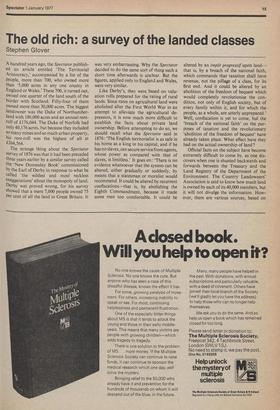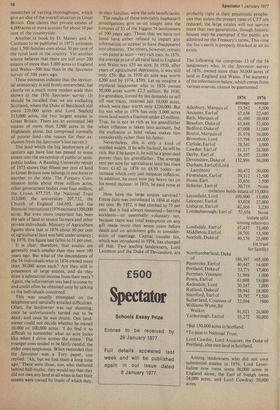The old rich: a survey of the landed classes
Stephen Glover
A hundred years ago, the Spectator published an article entitled 'The Territorial Aristocracy,' accompanied by a list of the people, more than 700, who owned more than '5,000 acres in any one county in England or Wales.' These 700, it turned out, owned one quarter of the land south of the border with Scotland. Fifty-four of them owned more than 30,000 acres. The biggest landowner was the Duke of Northumberland with 186,000 acres and an annual rentroll of £176,044. The Duke of Norfolk had only 40,176 acres, but because they included SO many mines and so much urban property, his rent-roll was the highest of all at £264,564.
The strange thing about the Spectator survey of 1876 was that it had been preceded three years earlier by a similar survey called the 'New Domesday Book' commissioned by the Earl of Derby in response to what he called 'the wildest and most reckless exaggerations' about the monopoly of land. Derby was proved wrong, for his survey showed that a mere 7,000 people owned 75 Per cent of all the land in Great Britain. It was very embarrassing. Why the Spectator decided to do the same sort of thing such a short time afterwards is unclear. But the figures, applied only to England and Wales, were very similar.
Like Derby's, they were based on valuation rolls prepared for the rating of rural lands. Since rates on agricultural land were abolished after the First World War in an attempt to alleviate the agricultural depression, it is now much more difficult to establish the facts about private land ownership. Before attempting to do so, we should recall what the Spectator said in 1876: 'The English territorialist is as safe in his home as a king in his capital, and if he has no slaves, can secure service from agents, whose power as compared with that of slaves, is limitless.' It goes on : 'There is no evidence whatsoever that the system can be altered, either gradually or suddenly, by means that a statesman or moralist would recommend. It could be altered by recurrent confiscations—that is, by abolishing the Eighth Commandment, because it made some men too comfortable. It could be altered by an imp& progressif upon land— that is, by a breach of the national faith, which commands that taxation shall have revenue, not the pillage of a class, for its first end. And it could be altered by an abolition of the freedom of bequest which would completely revolutionise the condition, not only of English society, but of every family wtihin it, and for which the people, as a whole, are utterly unprepared.' Well, confiscation is yet to come, but the 'breach of the national faith' on the purposes of taxation and the revolutionary 'abolition of the freedom of bequest' have already taken place. What effect have they had on the actual ownership of land?
Official facts on the subject have become extremely difficult to come by, as one discovers when one is shunted backwards and forwards between the Treasury and the Land Registry of the Department of the Environment. The Country Landowners' Association is said to know how much land is owned by each of its 40,000 members, but it will not divulge the information. However, there are various sources, based on researches of varying thoroughness, which give an idea of the overall situation in Great Britain. One claims that private estates of 4,000 acres or more account for about 10 per cent of the countryside.
Another (a book by D. Massey and A. Catelano to be published in 1977) estimates that 1,500 families own about 30 per cent of the rural land in the country. Yet another source believes that there are still over 200 estates of more than 5,000 acres in England and Wales-500 less than in the Spectator survey of 100 years ago.
These estimates indicate that the territorial aristocracy is still firmly entrenched, but clearly on a much more modest scale than shown in the 1876 Spectator survey. (It should be recalled that we are excluding Scotland, where the Duke of Buccleuch still owns 220,000 acres and Lord Seafield 113,000 acres, the two largest estates in Great Britain. There are an estimated 340 estates of more than 5,000 acres in the Highlands alone, but comprised normally of poorer land-the reason for their exclusion from the Spectator's last survey.) The land which the big landowners of a century ago have lost has passed to some extent into the ownership of public or semipublic bodies. A Reading University report of 1973 shows that fifteen per cent of land in Great Britain now belongs in one form or another to the state. The Forestry Commission holds about three million acres, other government bodies over four million, the Crown 477,735, the National Trust 313,000, the universities 207,732, the Church of England 164,692, and the financial institutions (1976 estimate) 300,000 acres. But even more important has been the sale of land to tenant farmers and other private individuals. Ministry of Agriculture figures show that in 1876 about 90 per cent of agricultural land was held under tenancy; by 1976, this figure had fallen to 31 per cnet.
It is clear, therefore, that estates are generally much smaller than they were 100 years ago. But what of the descendants of the 54 individuals who in 1876 owned more than 30,000 acres each ? Are they still in possession of large estates, and do they draw a substantial income from their rents? Again, the information was hard to come by and could often be obtained only by talking to the individuals concerned.
This was usually attempted on the telephone and naturally entailed difficulties. Often, the landowner was out shooting; once he unfortunately turned out to be dead; and once he was drunk. One landowner could not decide whether he owned 10,000 or 100,000 acres: 'I do find it so difficult to remember what an acre looks like when I drive across the estate.' The younger ones tended to be fairly candid, the older ones suspicious. When reminded that the Spectator was a Tory paper, one replied : 'Ah, but we lost them a long time ago.' There were those, too, who sheltered behind half-truths: they would say that they did not own any land at all when in fact their estates were owned by trusts of which they, or their families, were the sole beneficiaries. The results of these inevitably haphazard investigations give us an insight into the fortunes of 33 of the biggest 54 landowners of 100 years ago. Those that we have not listed have either refused to impart any information or appear to have disappeared into obscurity. The others, however, remain -on paper at least-very rich men. In 1876, the average price of all rural land in England and Wales was £53 an acre. In 1950, after years of agricultural depression, it was still only £56. But in 1970 an acre was worth £200 and by 1974, £599. Let us imagine a mythical landowner who in 1876 owned 50,000 acres worth £2.5 million. By 1930, his grandson, forced by tax demands to sell off vast tracts, retained just 10,000 acres, which were then worth only £230,000. But his son who in 1976 has only 5,000 acres owns land worth a fraction under £3 million. True, he is not as rich as his grandfather when inflation is taken into account, but the explosion in land values makes him considerably richer than his father.
Nevertheless, this is only a kind of ossified wealth. If he sells his land, he will be rich. But if he keeps it, he will be a great deal poorer than his grandfather. The average rent per acre for agricultural land has risen from £1.42 in 1876 to £8.95 today-an increase which only just outpaces inflation. In addition, he must now pay heavy tax on his rental income: in 1876, he paid none at all.
How have the large estates survived ? Estate duty was introduced in 1894 at eight per cent. By 1972, it had climbed to 75 per cent. But it had always remained-barring accidents-an essentially voluntary tax, because there was total exemption on any gift made more than seven years before death and on settlement gifts in consideration of marriage. Capital transfer tax, which was introduced in 1974, has changed all that. Two leading landowners, Lord Lambton and the Duke of Devonshire, are probably right in their pessimistic prophecies that unless the present rates of CTT are reduced, the large estates will not survive more than two generations, though historic houses may be exempted if the public are admitted on the Treasury's terms. This time the fox's earth is properly blocked at all its exists.
The following list comprises 33 of the 54 landowners who, in the Spectator survey of 1876, owned more than 30,000 acres of land in England and Wales. The accuracy of the information below, which comes from various sources, cannot be guaranteed.























































 Previous page
Previous page